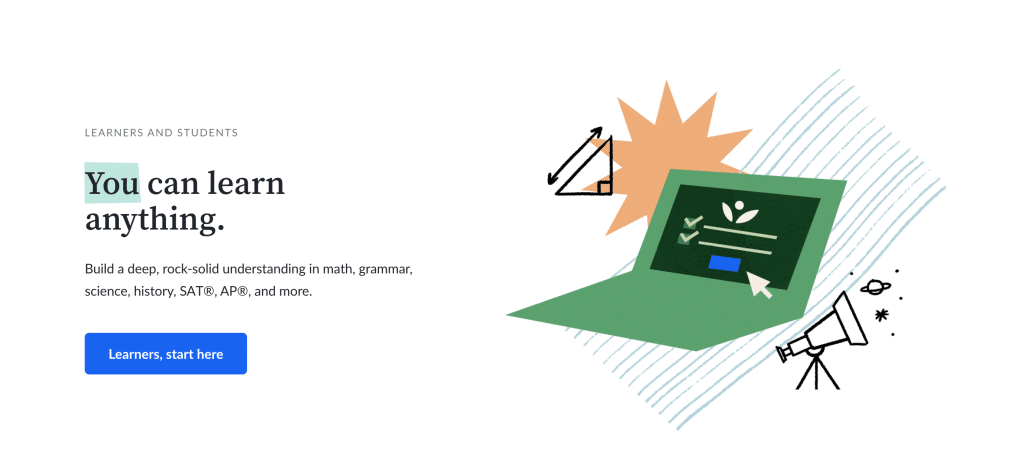What do you want your site visitors to do when they land on your homepage? You want them to be hooked, engaged, and curious enough to dig deeper and find out more about what you have to offer – right?
That’s much easier said than done, though, especially considering that 55% of visitors spend less than 15 seconds on any given website. That means you have a short window of opportunity to capture the attention of your website visitors and compel them to explore further.
That’s where a website hero message comes in. If you craft a compelling website hero message, you can hook your visitors in a matter of seconds and get them to stick around on your site. Here’s how to write one!
What Is a Hero Message?
A website hero message is a brief, powerful statement that captures the heart of your website—its core purpose, mission, or value. It’s often found at the top of a home page or above a fold on landing pages and serves to introduce visitors to what you have to offer.

Typically, the hero message is composed of a header (that’s usually the biggest in size), a clarifying sentence or two (in a slightly smaller font), and a call-to-action (CTA) that invites visitors to learn more about your site or take action.
What a Hero Message Should Do
It’s important to note that the hero message isn’t an advertisement, nor does it have to be salesy. It simply has to tell the visitor what you do, why they should care, and give them an invitation to take the next step. That way, you can quickly and effectively build trust with your visitors.
So, essentially, your hero message should do the following:
- Explain who you are as a company (your industry or niche)
- Summarize what you do and/or what you offer
- Demonstrate why visitors should care about your product, service, or offer
- Establish credibility and trust
- Help visitors quickly determine if your website, product, or service will be useful to them
- Entice visitors to perform your desired call to action (CTA)
4 Steps to Writing a Compelling Hero Message
Now that you know what hero messages are and what they should do, let’s walk through the steps of creating one.
1. Choose a Powerful Header
The header is arguably the most important part of your hero message, so be sure to choose a powerful phrase that clearly communicates what you do in a concise and captivating way. Aim to keep it short (no more than 20 words) and use strong, attention-grabbing language.
There are two things to remember in this step:
- Write in a way that’s easy to understand (avoid buzzwords, jargon, and industry-specific terms)
- Make sure it’s clear enough that visitors understand what your company does in a matter of seconds. You also want to make it about your visitor (what’s in it for them) rather than about you (what your company does).
For instance, instead of simply saying, “We’re the leading provider of custom web design solutions”, you could say something like,
“Transform Your Website Into a Lead-Generating Machine With Our Custom Web Design Solutions”
What makes this so compelling? It’s focused on the visitors and quickly conveys what the company does (web design) in a clear and exciting way.
2. Add a Clarifying Sentence
Now that you have your header, it’s time to add a clarifying sentence (or two). This is where you can provide more details about your product, service, or offer. You want to make sure the visitor knows exactly what they’re getting from you and why they should choose you in no more than two sentences.
Here’s where you can explain how you will help them and the benefits they can experience by focusing on your offer and unique selling point. For instance, picking up on the previous example, you could add something like “Websites that accurately reflect your brand and turn visitors into loyal customers by providing an intuitive user experience.”
In just a sentence, this showcases that your unique selling point is the focus on user experience and how this will result in more customers.
3. Include a Call-to-Action
At this point, your visitors now know who you are and what you offer. Now it’s time to give them the invitation to take action, which is done by including a CTA in your hero message.

Image Source: khanacademy.com
Your CTA should be kept short and sweet—you don’t want visitors to feel overwhelmed by too much text in your hero section. And, like with your header and clarifying sentence, you want to make sure the copy of your CTA is clear, compelling, and focused on the visitor.
A few examples include:
- “Discover How We Can Help Your Business”
- “Start Building Your Brand Today”
- “See Our Services In Action Now”
With the CTA, make sure you’re choosing the most relevant one for your hero message. Ask yourself, “What do I want visitors to do next?” If you’re promoting a specific product or service, make sure the CTA is related to that, so they don’t get confused.
4. Choose Your Hero Image
The hero image is the final step in crafting your message. This is the image that sits front and center on your homepage, so make sure it’s high-resolution and visually appealing. Some websites have videos as their hero images, while others use still photos or illustrations. Similarly, some hero images occupy the entire page while others are aligned left, right, or sit atop the fold.
While there are no strict rules on what kind of image you should use, remember that the hero image should be relevant to the message you’ve created and have some kind of visual connection with it. Plus, don’t let it distract visitors from the main focus—the message.

Image Source: surfrider.org
Some types of hero images include people, places, close-up shots of products, illustrations or contextual images, emotional images, and more. Each one has its purpose, so it’s important to carefully consider which ones you want to use and why.
For instance, for personal brands, it’s often best to have a headshot of the founder or company owner. For product-based companies, showing off a photo of your product in its natural environment might make sense. In contrast, a contextual or emotional image might be the best choice if you’re trying to evoke a certain emotion or create a sense of urgency.
What matters is that your hero image is relevant to the message and has a purpose for being there. Once you’ve chosen it, make sure to include the CTA in the same space as the image.
Tips to Keep in Mind While Crafting Your Hero Section
While the process is quite easy, many websites tend to miss the mark when it comes to creating an effective hero message. To make sure this isn’t the case for your website, here are a few tips to keep in mind:
Be Straightforward
It can be very tempting to get creative with your hero message, but it’s best to keep it simple and straightforward. You want visitors to understand what you offer without feeling confused or overwhelmed. No one will take the time to decipher a complex message, so resist the urge to get too creative.
Let’s say you’re a web design agency. Don’t get too clever with words and phrases like “we craft digital dreams”—it sounds nice, but what does it mean? Stick to something more direct such as “We Help Companies Design Websites That Get Results.”
Speak to Your Target Audience
A lot of people are afraid of getting too specific, but if you want your hero message to be effective, it’s important to write it with one main audience in mind. While there are some general similarities among most consumers, they still have different needs and wants. Focus on understanding what those are for your target audience and craft the message accordingly.
You don’t necessarily have to name them in your message, but they should be able to tell it’s meant for them. For instance, if you’re targeting entrepreneurs, instead of saying, “Help Your Business Grow,” you might say, “Take Your Startup to the Next Level.” “Business” may be too broad for them to connect with, but “startup” resonates more.
Connect Your Hero Message With Your Mission Statement
For your messaging to be coherent and consistent, it should always be in line with your mission statement. For instance, if the reason behind the existence of your business is to make life easier for entrepreneurs, your hero message should somehow reflect that. Your mission can’t be one thing and the message another, or else it won’t be believable.
In other words, the “why” behind your business should be reflected in the “what” of your hero message. If the two are connected, visitors will be more likely to trust your offering and take the next step. But if it’s all over the place, they won’t take you seriously.
Focus on Benefits, Not Features
Sometimes, it’s easy to get caught up in talking about the features of your product or service, but that’s not always the most effective way. Instead, focus on how those features will benefit your potential customers. This will help them understand why they should choose your business over others and why your offering is worth their time and money.
For instance, saying, “We Have the Latest Technology,” isn’t as effective as “Our Technology Will Help You Work Smarter and Faster.” The former is just a feature, while the latter speaks to how that feature will benefit them.
Include a Target Keyword
For SEO purposes, it’s still important to include your target keyword in the hero message. This is especially since most hero messages make up the H1 of your website. However, make sure you do it naturally and don’t just stuff it in there to rank higher on Google.
It should be part of a sentence that makes sense and will help users quickly understand what your page is about. For example, if your target keyword is “website design”, you can write something like: “Let Us Take Care of Your Website Design Needs” or “Website Design Made Easy”.
Optimize Your Hero Image for Fast Loading
Your hero image needs to be attractive and in line with the message, but it also needs to serve a practical purpose. You don’t want it to take forever for visitors to load, or else they’ll end up clicking away from your page. Make sure that you optimize your images for faster loading times by using tools such as TinyPNG or Compressor.io.
Always Test!
Finally, don’t forget to test different versions of your hero message and image to find out what works best for your visitors. Eventually, you’ll be able to come up with the perfect combination that resonates with them. Your hero isn’t set in stone and should be revised regularly as needed.
To do that, create A/B tests to compare different messages and images against each other. This will give you a better understanding of what content works best for your target audience, which will help you optimize your hero message accordingly.
In Conclusion
Effective copywriting and the right hero image go a long way in making your website stand out. With so many sites fighting for attention online, it’s more important than ever to create a strong first impression with an effective hero section. By following the tips mentioned above, you’ll be able to craft a compelling message and ensure visitors keep coming back for more.
At ShiftWeb, we not only design websites that are optimized for performance and conversions, but we also help you create an effective hero message that will connect with your audience with our copywriting services. Are you ready to level up your website with an effective hero message? Contact us today.


